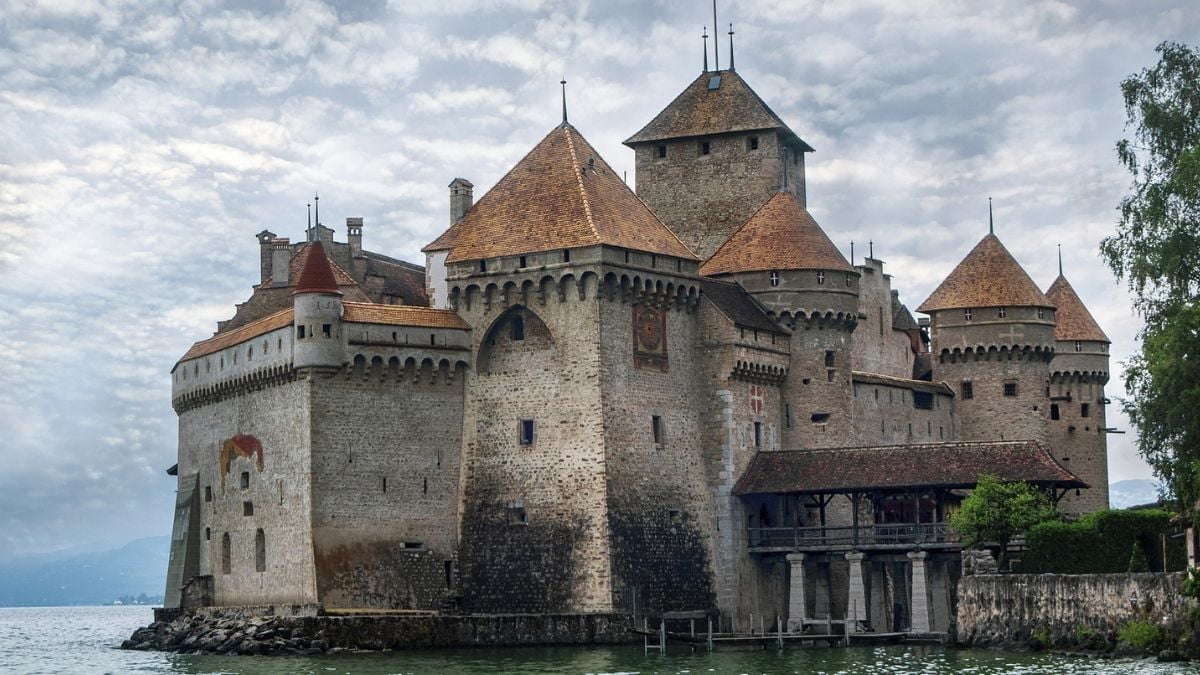Chillon Castle, also known as the Water Fort, is one of Switzerland’s most visited historic structures. Chillon Castle Switzerland was the cheapest tariff center and residence in Savoy County for four centuries. The Chillon Castle, Lake Geneva, and the rocky island between the sloping hills are said to have been inhabited as early as prehistory. Now let us look at some Chillon Castle facts.
Where is Chillon Castle located?
Chillon Castle is an island fort in Lake Geneva, south of Veytaux in the canton of Vaud in Switzerland. Chillon Castle is located on the lake’s eastern edge, on the narrow coast between Montreux and Villeneuve, providing access to the Rh ne Alpine Valley. Where is Chillon Castle located? Now you know the answer for that question.
What is the Chillon Castle Location’s Importance?
Chillon Fort was constructed on Chillon Island. Lake Geneva is situated on a sloping side, with Montreux and Villeneuve on one side and the lake on another. It has a sloping bottom and an oval limestone rock. Furthermore, the palace’s location is strategic: it guards the passage between the Vaud Riviera and the Rh ne Valley, the shortest route to Italy, allowing northerly access to Germany and France. It also has a fantastic view of Savoyard Beach. Due to this, Chillon Castle holds an important position in terms of location. Chillon Castle Switzerland is one of Switzerland’s and Europe’s most popular medieval castles.
Why is the Chillon Castle famous?
Do you know before why is the Chillon Castle famous for? Chillon Castle is a medieval castle that is celebrated for its gorgeousness and is widely regarded as one of Europe’s best preserved medieval castles. According to newspaper reports, Chillon Castle is now Switzerland’s most visited historical monument, with 400,000 visitors each year.

Who lived in Chillon Castle?
The rival Habsburg dynasty, which had reached its pinnacle during the Italian War, put pressure on the Savoy House. As a result, Vaud was conquered from the Catholic Savoy by the Protestant Canton Bern army of the Swiss Confederation, the historical forerunner of modern-day Switzerland. After a three-day siege, it was captured by the Chilon Palace on March 29, 1536. Chillon Castle Switzerland remained silent for the next 260 years as a fortress, depot, and prison under Bernice Switzerland. It served as a hospital, and Bernice allowed the fort to become Weavy’s hostage’s residence. Now you know who lived in Chillon Castle Switzerland.
Chillon Castle History
Talking about Chillon Castle history there are lots of facts to tell. However, Chillon has been a military site since the Roman period, and the present castle was built during three distinct periods: the Savoy Period, the Bernese Period, and the Vaudois Period. Chillon began as a Roman outpost guarding the strategic road through the Alpine passes during the Roman period. During 19th-century excavations, objects from the Roman period, as well as Bronze Age remains, were discovered. The Romans would have fortified the site with a double wooden palisade before adding a square donjon in the 10th century. According to 13th-century sources, the Bishop of Sion was the owner of the Chillon site.
The oldest parts of the castle have not been definitively dated during the Savoy period, but the first written record of the castle was in 1005. It was built to keep the road from Burgundy to the Great Saint Bernard Pass under control. From the mid-12th century, the castle served as the summer residence of the Counts of Savoy, who maintained a fleet of ships on Lake Geneva. Count Peter II greatly expanded the castle in 1248 and 1266-7. The distinctive windows were added during this time period by Master James of Saint George, who has also been thought to have added similar windows to Harlech Castle in Wales at a later date.

The current iteration of Chillon Castle Switzerland is the result of generations of construction and re – development. Excavations, particularly those carried out by archaeologist Albert Knife since the late nineteenth century, show that the site dates back to the Bronze Age. The fort was built in the oval shape of the island on which it was built. It is approximately 100m long and 50m wide. The rocky island on which the fort was built had both natural defenses and strategic positioning to control the movement of Europe from north to south. In this way the Chillon Castle history is fourfold.
Chillon Castle Inside and Layout
Now we’ll go over the Chillon Castle inside and outside. When discussing the Chillon Castle inside and outside, the first thing to note is that Savoyard-style palaces are typically built on a square plot of land. Each corner is surrounded by cylindrical columns. Chilon Castle is also unique in that it is shaped like the oval of the rocky island on which it was built. The fort is surrounded by a natural moat and can be reached from all sides via the lake. It is classified as a ‘water fort.’ A Chillon bridge connects it to the mainland as well.
Chilon is a dual-purpose fortress: the north face was a defensive line guarding the Franciscan Road, with arrows and then holes piercing it, and macchiatrines ascending it. The general landscape of Lake Vodivier, Lake Geneva, and the mountains adorns the face of the royal palace on the south side, facing the lake. A watchman walk connects the store and treasure room in the center to the Corps de Logis. The Chillon Castle inside space is composed into three major courtyards, each of which corresponds to the use of the surrounding buildings: the Castilene and the master’s dwellings, which extends to the feudal system.

